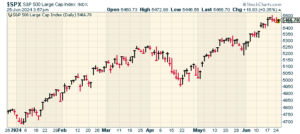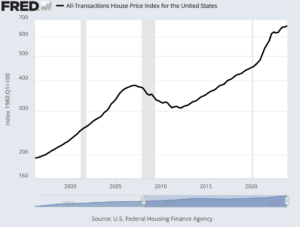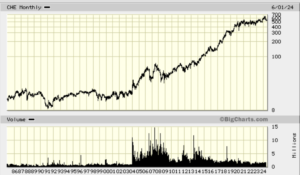CWS Market Review – June 25, 2024
(This is the free version of CWS Market Review. If you like what you see, then please sign up for the premium newsletter for $20 per month or $200 for the whole year. If you sign up today, you can see our two reports, “Your Handy Guide to Stock Orders” and “How Not to Get Screwed on Your Mortgage.”)
Tomorrow is the 11-month anniversary of the Federal Reserve’s last rate hike. On July 26, 2023, the FOMC voted to raise its target range for the Fed funds rate to 5.25% to 5.50%. Since then, the Fed hasn’t made a single change to rates.
It’s odd how doing nothing can receive so much attention. Still, I must acknowledge that the stock market has done very well under steady rates, especially since last October. Sometimes doing nothing is the right thing to do.
This has also become a surprisingly calm market. The S&P 500 has only had very small down days this month. We haven’t had a 2% daily loss since February 2023.
Here’s an interesting stat: The S&P 500 hasn’t closed lower by more than 0.75% in a single day for the last 38 trading sessions in a row. Bear in mind that a fall of 0.75% isn’t that much. For some context, in 2022, we had 77 daily drops of more than 0.75%.
We’re still a long way from the record. In 1965-66, the stock market went for 135 days in a row without a drop of more than 0.75%.
Home Values Reach New High
Thanks to the Fed’s rate hikes, mortgage rates have increased. The 30-year fixed-rate mortgage rose sharply last month. While that has impacted the overall housing market, home prices are still rising.
This morning’s Case-Shiller index on home prices said that home values are at an all-time high. For April, home prices on its 20-city index increased by 0.4%.
Over the last year, prices on the 20-city index are up by 7.2% which is down slightly from the 7.5% increase for the 12 months ending in March. The broader national index increased by 0.3% in April and is up by 6.3% over the last year. All these price indexes are at all-time highs.
A separate report from the Federal Housing Finance Agency said that home values increased by 0.2% in April and are up 6.3% over the last year. The median price of a resale home was $407,600 in April, and a newly built home was $433,500.
Sales are down yet sales prices are higher than ever. What’s going on? Moses Sternstein makes the point that the sales indexes only capture what’s selling, but right now, the important factor is what’s not selling.
In other words, more owners might be willing to sell if buyers could afford it, but the people who are buying right now could simply be less price sensitive. In fact, homebuilders have been cutting prices, which makes sense to me. I trust what the homebuilders are doing more than what the sales indexes are saying. For most homeowners, home values are not rising.
Will Interest Rates Soon Come Down?
Will the Fed start cutting rates soon? Beats me, but Fed Governor Michelle Bowman said she’s open to seeing more rate hikes if inflation doesn’t pull back. In a speech today, Governor Bowman said that we’re not yet at the point to look for interest rates come down.
This places her with other Fed officials who have acknowledged lower inflation but still want to see more evidence that inflation is no longer a threat. I’ve been surprised by how united the Fed appears to be on this point.
We’ll learn more on Friday when the Commerce Department releases its PCE price index report. This report always comes out the day after the GDP report. (I’ll also be curious if the Q1 GDP report is revised lower again.)
As I often say, the PCE is the Fed’s preferred measure of inflation. Wall Street expects that the PCE will have increased by 2.6% over the 12 months ending in May. This is for the headline and core PCE. The Fed has a 2% target for inflation. I’m surprised at how firm the Fed has been publicly to achieving its 2% target.
The current consensus is that the Fed won’t change interest rates at its next meeting which is at the end of July. However, Wall Street expects the Fed to cut rates in September. The futures market thinks there’s a 68% chance that the Fed will cut in September.
The direction of interest rates has a major impact on the stock market. For one, interest expense is a major item for many companies. Lower rates also help larger companies buy smaller ones. Lower rates provide weaker competition for stocks so share prices can afford to go higher.
There’s also an important impact within the stock market. When rates go down, investors tend to favor value stocks, but as rates stay up, like they are now, growth stocks tend to do well. We’ve certainly seen that this year, especially in the last few weeks.
The current stock market has been dominated by one growth stock above all others, Nvidia (NVDA). Nvidia has gotten so big that its news can move the entire market. From last Thursday’s high to yesterday’s low, Nvidia lost 15.5%. That’s over $500 billion in market value.
Fortunately, that selloff came to a quick end today. Shares of NVDA rallied 6.8% today which helped lift the entire Nasdaq. For the day, the Nasdaq was up by more than 1.25% while the Dow was down 0.76%. Interestingly, that nearly perfectly mimicked the growth/value divide today. The S&P 500 Growth ETF gained 1.25% today while the S&P 500 Value ETF lost 0.8%. That’s a wide gap even for this point in the market. Once rates start to go down, this may all unwind.
Stock Focus: Chemed
This week, I wanted to tell you about Chemed (CHE). I can’t fairly say that Chemed is unknown on Wall Street. It’s currently followed by three analysts, but it deserves a lot more attention.
Chemed is also one of the most unusual publicly traded companies I know of. Based in Cincinnati, Chemed runs two wholly-owned subsidiaries. One is VITAS Healthcare which is the country’s largest provider of end-of-life hospice care. The other subsidiary is Roto-Rooter.
I’m not making this up. Chemed runs hospice care and Roto-Rooter, the plumbing folks. I can’t imagine a more dissimilar business. Hey, it works for them so I’m all for it. Chemed has over 15,000 employees and a market value of $8 billion.
On this day in 1991, you could have picked up shares of CHE for about $10.44 apiece. Today, 33 years later, CHE is going for $540 a piece. That’s a gain of more than 50-fold.
Last year, Chemed made $20.23 per share. The analyst community, all three of them, looks for Chemed to make $23.21 per share this year and $25.28 next year as well. The company has increased its dividend for the last 14 years in a row. I expect to see another increase this August.
I’m showing you Chemed because there’s an important lesson for investing here. Any company can be a very profitable business, even seemingly unusual ones. Don’t be afraid to go off the beaten path in order to find superior companies. There aren’t many stocks up 50-fold in 33 years, but Roto-Rooter did it. I’m sure there’s another out there right now.
That’s all for now. I’ll have more for you in the next issue of CWS Market Review.
– Eddy
Posted by Eddy Elfenbein on June 25th, 2024 at 4:54 pm
The information in this blog post represents my own opinions and does not contain a recommendation for any particular security or investment. I or my affiliates may hold positions or other interests in securities mentioned in the Blog, please see my Disclaimer page for my full disclaimer.
-
-
Archives
- April 2025
- March 2025
- February 2025
- January 2025
- December 2024
- November 2024
- October 2024
- September 2024
- August 2024
- July 2024
- June 2024
- May 2024
- April 2024
- March 2024
- February 2024
- January 2024
- December 2023
- November 2023
- October 2023
- September 2023
- August 2023
- July 2023
- June 2023
- May 2023
- April 2023
- March 2023
- February 2023
- January 2023
- December 2022
- November 2022
- October 2022
- September 2022
- August 2022
- July 2022
- June 2022
- May 2022
- April 2022
- March 2022
- February 2022
- January 2022
- December 2021
- November 2021
- October 2021
- September 2021
- August 2021
- July 2021
- June 2021
- May 2021
- April 2021
- March 2021
- February 2021
- January 2021
- December 2020
- November 2020
- October 2020
- September 2020
- August 2020
- July 2020
- June 2020
- May 2020
- April 2020
- March 2020
- February 2020
- January 2020
- December 2019
- November 2019
- October 2019
- September 2019
- August 2019
- July 2019
- June 2019
- May 2019
- April 2019
- March 2019
- February 2019
- January 2019
- December 2018
- November 2018
- October 2018
- September 2018
- August 2018
- July 2018
- June 2018
- May 2018
- April 2018
- March 2018
- February 2018
- January 2018
- December 2017
- November 2017
- October 2017
- September 2017
- August 2017
- July 2017
- June 2017
- May 2017
- April 2017
- March 2017
- February 2017
- January 2017
- December 2016
- November 2016
- October 2016
- September 2016
- August 2016
- July 2016
- June 2016
- May 2016
- April 2016
- March 2016
- February 2016
- January 2016
- December 2015
- November 2015
- October 2015
- September 2015
- August 2015
- July 2015
- June 2015
- May 2015
- April 2015
- March 2015
- February 2015
- January 2015
- December 2014
- November 2014
- October 2014
- September 2014
- August 2014
- July 2014
- June 2014
- May 2014
- April 2014
- March 2014
- February 2014
- January 2014
- December 2013
- November 2013
- October 2013
- September 2013
- August 2013
- July 2013
- June 2013
- May 2013
- April 2013
- March 2013
- February 2013
- January 2013
- December 2012
- November 2012
- October 2012
- September 2012
- August 2012
- July 2012
- June 2012
- May 2012
- April 2012
- March 2012
- February 2012
- January 2012
- December 2011
- November 2011
- October 2011
- September 2011
- August 2011
- July 2011
- June 2011
- May 2011
- April 2011
- March 2011
- February 2011
- January 2011
- December 2010
- November 2010
- October 2010
- September 2010
- August 2010
- July 2010
- June 2010
- May 2010
- April 2010
- March 2010
- February 2010
- January 2010
- December 2009
- November 2009
- October 2009
- September 2009
- August 2009
- July 2009
- June 2009
- May 2009
- April 2009
- March 2009
- February 2009
- January 2009
- December 2008
- November 2008
- October 2008
- September 2008
- August 2008
- July 2008
- June 2008
- May 2008
- April 2008
- March 2008
- February 2008
- January 2008
- December 2007
- November 2007
- October 2007
- September 2007
- August 2007
- July 2007
- June 2007
- May 2007
- April 2007
- March 2007
- February 2007
- January 2007
- December 2006
- November 2006
- October 2006
- September 2006
- August 2006
- July 2006
- June 2006
- May 2006
- April 2006
- March 2006
- February 2006
- January 2006
- December 2005
- November 2005
- October 2005
- September 2005
- August 2005
- July 2005



 Eddy Elfenbein is a Washington, DC-based speaker, portfolio manager and editor of the blog Crossing Wall Street. His
Eddy Elfenbein is a Washington, DC-based speaker, portfolio manager and editor of the blog Crossing Wall Street. His